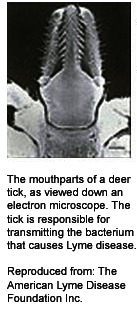NCBI Bookshelf. A service of the National Library of Medicine, National Institutes of Health.
Dean L, McEntyre J, editors. Coffee Break: Tutorials for NCBI Tools [Internet]. Bethesda (MD): National Center for Biotechnology Information (US); 1999-.
Diseases spread by ticks are not recent phenomena to the New World. However, one tick-borne disease, known in Europe since the beginning of the century, has only recently emerged in the United States and is now the most common tick-borne disease on this side of the Atlantic.
In the mid-1970s, a number of residents of the small town of Lyme in Connecticut were afflicted with an unusual arthritis-like condition. Most new cases were observed in the summer and early fall of each year, and the incidence was soon linked to recent tick bites in a high percentage of patients.

We now have the full sequence of the B. burgdorferi genome. It has a total of 853 genes on one linear chromosome and an additional 430 genes on 11 plasmids. The chromosomal genes are required for cell growth, although there are no genes present that are involved in the synthesis of amino acids, fatty acids, enzyme cofactors, or nucleotides. The genes on the plasmids may be involved in infectivity and virulence. One of the chromosomal genes codes for "outer surface protein A" (OspA), which has been the focus of a search for a vaccine against Lyme disease. Recent clinical trials using a recombinant form of OspA as a vaccine look extremely promising.
But what of the relatives of B. burgdorferi? Perhaps one of the most infamous of these is Treponema pallidum, the bacterium that causes syphilis. in contrast to Lyme disease, syphilis is not a modern affliction; it was first recognized in the 15th century in Europe. It is similar to B. burgdorferi in that it is a spirochete with a relatively small genome and requires a host to survive; however, at the genomic level, the two organisms are not very closely related to each other at all.
Of the 1041 protein-coding regions in Treponema pallidum, 476 are shared with B. burgdorferi, but nearly half of these are common to other bacteria too, and most have a predicted biological function. Of the genes with unknown function, there are about 50 that are conserved only in the spirochetes and are not found in any other bacteria. Some of these are likely to represent genes that code for spirochete-specific traits, such as their helical shape and perhaps elements of their pathogenicity.
The comparison of whole genomes may help pinpoint genes that make an organism a successful pathogen or suited to living in a particular environment. Furthermore, the identification of related genes in different species gives a new twist to the classification of different organsims, deepening our understanding of their relationship to each other across the whole evolutionary spectrum.
Search PubMed for gene sequencing of Lyme disease
Created: September 1, 1999
Click on the link below to start an html tutorial.
How is gene sequencing helping us understand Lyme disease?
Search PubMed for Lyme disease and syphilis
Created: September 1, 1999
Click on the link below to start an html tutorial.
Where do Lyme disease and syphilis converge?
Use BLAST to search for an ATPase found in spirochetes
Created: September 1, 1999
Click on the link below to start an html tutorial.
An unusual way to generate energy in the spirochetes?
- What do Lyme disease and syphilis have in common? - Coffee BreakWhat do Lyme disease and syphilis have in common? - Coffee Break
Your browsing activity is empty.
Activity recording is turned off.
See more...

